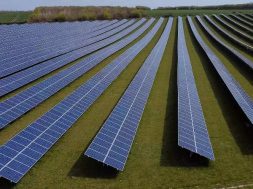
Printed in-situ Perovskite Solar Cells Save Resources and Can Be Produced Locally
Photovoltaics (PV) is one of the key technologies of a sustainable energy supply based on renewable energy. Besides silicon-based photovoltaics, which presently dominates the market, there are other materials, such as perovskite, that also show great potential. Scientists are testing the proof of concept of these new types of solar cells. Very innovative is a new process for fabricating solar cells using sustainable and more resource-friendly methods. Hereby the number of production steps can be drastically reduced by reversing the manufacturing process. Such an in-situ concept for printed perovskite solar cells is being developed by the Fraunhofer Institute for Solar Energy Systems ISE. With a record efficiency of 12.6 %, the researchers have now reached an important milestone in the field of printed photovoltaics.
Today silicon solar cells dominate the global photovoltaic market. They are produced using numerous processing steps starting with the synthesis of the photoactive material through to the solar cell fabrication then subsequently interconnected and encapsulated in a solar PV module. With the material perovskite and the goal of reducing the number of processing steps, the research group around Dr. Andreas Hinsch at Fraunhofer ISE asked the question: Why can’t we reverse the manufacturing process so that first the solar module is produced and subsequently filled with the photovoltaic material then directly activated on site, or “in-situ”? “With perovskite, a photovoltaic material that is currently being intensely investigated, and a photoactive salt, we have now succeeded, for the first time, in realizing a printed solar cell with an efficiency of 12.6 %,” reports a pleased Andreas Hinsch. He adds: “With this success, we have achieved a first, important milestone in upscaling this technology and moving it towards industrial production.” That aside, the certified laboratory efficiency that we reached is also a new record for printed solar cells in general.
Printed Electrodes Combine with Perovskites
The methods developed for the printed “in-situ” perovskite solar cells on small areas and the results achieved form the basis for investigations on upscaling. The aim of the current project is to develop printable nanoporous electrode layers for the internal deposition and coupling of the perovskite crystals, to optimize the homogeneity of the process and to provide proof-of-concept for high solar efficiencies in the fabricated cells. In particular, the processing steps “Screen printing of the electrode layers” and “Activating the perovskite” are optimized. The thickness of the realized photovoltaically active layers is less than one micrometer.
Decisive for the solar cell efficiency is being able to control the deposition process of the perovskite crystallites within the nanoporous electrode, which is comprised of metal oxides and micronized graphite. New is the process used by the Fraunhofer researchers to fill the otherwise completed cell with perovskite and the subsequent crystallization. While the processes up to now led to uncontrolled crystal growth, the researchers around Hinsch have found a way to convert the perovskite to a molten salt at room temperature using a polarized gas, and so were able to fill the pores of the electrode. The final desorption of the gas greatly increases the melting point and brings about the crystallization. The result is a homogenous growth process. Photoactive layers manufactured in this manner show a high photovoltage of 1 volt and have led to the certified stable solar efficiency of 12.6 % for in-situ laboratory cells (0.1cm²) with graphite electrodes. The Fraunhofer scientists expect further efficiency improvements for their printed in-situ perovskite solar cells, not least because the perovskite material already has demonstrated efficiencies up to 22 %, as evidenced in the scientific papers on non-scalable laboratory cells.
Saves Resources and Able to be Produced Locally
Besides the anticipated lower costs of the perovskite solar cells developed at Fraunhofer ISE, the sustainability and complexity of the production process play a role. Due to the rapid increase in production capacity of conventional PV technologies, the costs of photovoltaics have decreased immensely. In addition to furthering cost reductions, the focus is now on the sustainability aspects of the technology. Still a young technology, photovoltaics still shows potential for improvement in energy and material consumption. Materials and concepts must be developed that offer alternatives in the medium and long term.
Fraunhofer ISE with its worldwide unique research work in efficient in-situ solar cells aims for a photovoltaic production that saves resources and can be produced locally. The processing steps used for the 12.6 % solar cell are similar to those used in the glass industry. Therefore, it is possible to also produce this new technology decentrally at local production plants with simple infrastructures, rather than exclusively at high-tech locations. By using inexpensive graphite and due to the facile synthesis of the used perovskite material, the material costs are quickly reduced to simply the cost of the glass substrate. For future marketing, the business model for this form of printed in-situ perovskite solar cells could be taken from the glass production and manufacturing industry. This means that based on the low material costs, the share of the transport costs become so significant that production and sales at a local level could compete with centralized production.
Fraunhofer ISE coordinates the group project “MesoPIN” which deals with the material development for printed perovskite solar cells. Along with Fraunhofer ISE, the project partners are the University of Constance, the University of Bayreuth and the University of Freiburg as well as the company Opvius GGmbH in Nuremberg and Kitzingen und the company Thieme in Teningen.
Aside from its focus on silicon solar cells, Fraunhofer ISE performs research on III-V semiconductor compounds and on novel photovoltaic technologies such as organic, dye and perovskite solar cell technologies.













